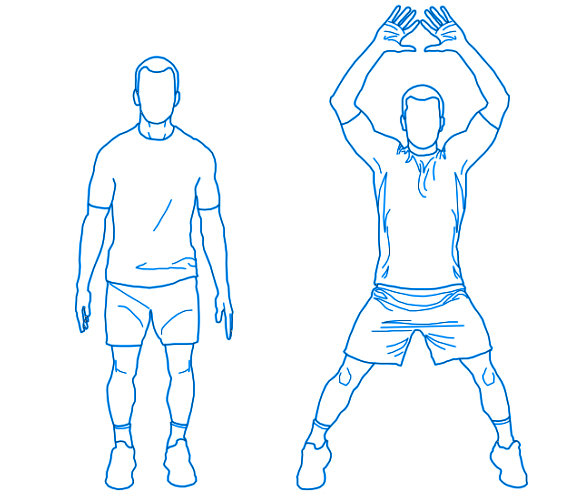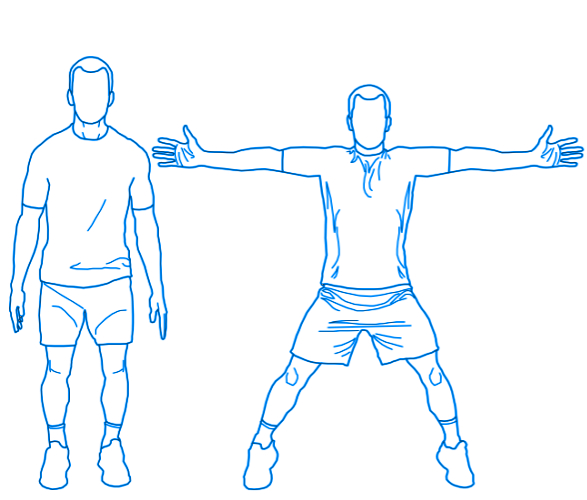These warm-up exercise integrate posture-building movements and holds to build strength in the upper back, rear shoulders, hips, and core. It also stretches muscles in the lower back, hamstrings, and pectorals. The goal is to train proper retraction of the shoulders, proper flexion and extension of the neck, and continuous engagement of the hips.
- Jumping Jacks.
- Half Jacks.
- Torso Twists.
- Jumping Twists.
- Lat Stretch.
- Pec Stretch.
- Good Mornings Stretch.
- Face-to-Wall Squats.
- IT Band Stretch.
- Prone Cobra.
1 & 2) Jumping Jacks & Half Jacks
Jumping jacks are easy to perform and they activate muscles throughout the body in a movement that seeks symmetry at all phases. Jumping jacks activate and stretch the legs, arms, and shoulders while also recruiting stabilizers in the neck, abdominal muscles, posterior chain, and hips.
Execute each using full range-of-motion while maintaining symmetrical form and alignment of the hands, shoulders, ankles, and hips for each repetition.
Work against asymmetry and any sway-back or forward-hunching posture by using the power and speed of each upstroke and downstroke. Take advantage of the body’s tendency to seek symmetry when performing jumping jacks. Intensity can be increased by increasing repetitions.
Standard Jumping Jack (Left) and Half Jack (Right)
Tips & Pointers:
- Keep the shoulders retracted and hips engaged (squeeze the glutes) during exercise; maintain an upright head with chin tucked.
- Avoid slapping one’s sides on the downswing.
- Keep wrists and elbows and wrists aligned with shoulders during upswing and downswing; palms should face forward and remain fully supinated.
- Jump and land on the toes; don’t let the heels touch the ground.
- Use a 4-count per repetition (1 Repetition = 1 Upswing 2 Downswing, 3 Upswing, 4 Downswing).
3) Torso Twists
Torso twists are easy to perform while training flexibility and mobility the hips and upper torso by strengthening and stretching muscles of the abdominals, obliques, hips flexors, and shoulders.
The upper torso twisting motion helps create flexibility and range-of-motion between the hips and upper torso.
Using the neck to stabilize the head with one’s shoulders during each repetition, torso twists can also address forward-head posture. Integrating a “T” position using the arms helps train retraction of the shoulders and engagement of the upper back during each twist.
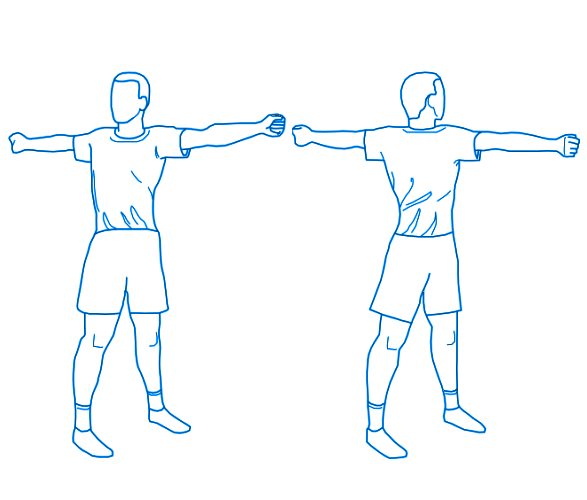
Tips & Pointers:
- Hold arms at “T” position, keeping shoulders retracted and engaged.
- Be sure to press both feet into the ground throughout exercise.
- Each twist should turn 45-60 degrees.
- Emphasize each twist by engaging hips and obliques.
- Use a 4-count per repetition.
4) Jumping Oblique Twists
Jumping Oblique Twists are somewhat of an inversion of Torso Twists that train the same muscles and movements while incorporating a jumping motion using lateral rotation of the hips rather than the upper torso.
Jumping Twists train flexibility and range-of-motion between the hips and upper torso.
This exercise is commonly used by boxers, dancers, and swimmers to train transfer of power between the lower and upper body.
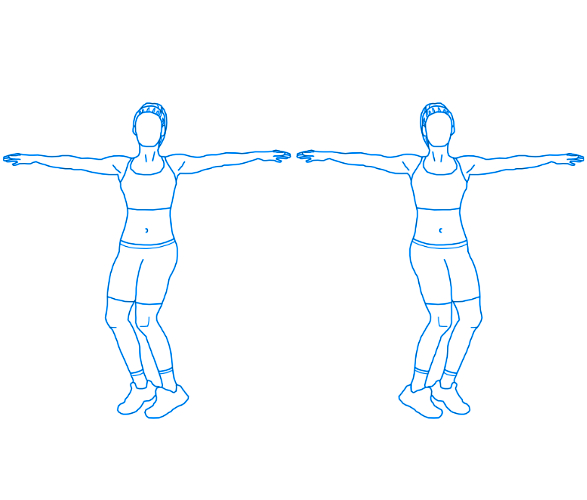
Tips & Pointers:
- Hold arms at “T” position, keeping shoulders retracted and engaged.
- Jump and land on the toes; don’t let the heels touch the ground.
- Keep hips square with direction of the feet.
- Twist angle should be 45-60 degrees.
- Use a 4-count per repetition.
5) Lat Stretch
Tight lats will affect range-of-motion for any movements which require proper rotation of the shoulder blades. This includes overhead lifts and forward pushing motions.
Stretching the lats will benefit the shoulders while improving overall flexibility and mobility of the upper torso. Lat stretches aid upper body motions such as throwing a ball, swinging a bat, and overhead presses.
Ideally, this stretch is performed using any lateral bar resting at hip height, or it can be performed using both sides of a door knob.
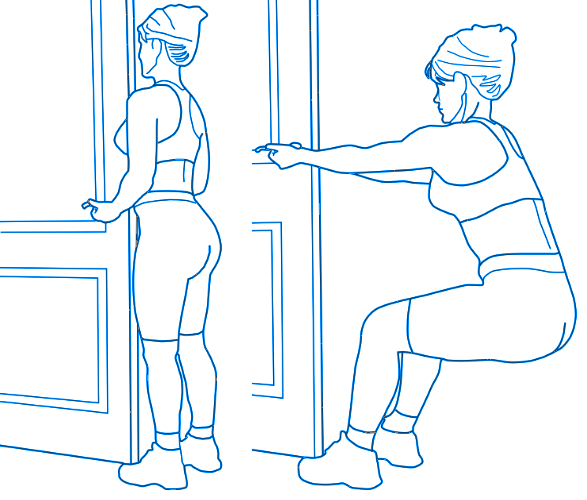
Tips & Pointers:
- Drive feet into the ground during all phases of stretch.
- Keep the knees aligned above the ankles.
- Keep a flat, extended back during stretch.
- Move the hips backwards and down to create stretch in the lats.
- Use a supinated grip.
6) Pec Stretch
With proper retraction of the shoulders, they rest in an aligned neutral position with the ears, hips, and ankles. This neutral position of the shoulder should be a starting point for lifts that use the shoulders to stabilize the arms during pushing and pulling motions.
Stretching the pectorals will help alleviate strained pectorals that dominate the position of the shoulders and shoulder blades, rolling them toward the front of the body. Stretching increases range-of-motion to properly train the upper back and rear shoulders. This allows full retraction of the shoulders for exercises meant to address forward hunching.
Pec stretches are also useful for increasing range-of-motion of the rotator cuff. By training flexibility and mobility of the rotator cuff, they increase power and precision for throwing and swinging motions.
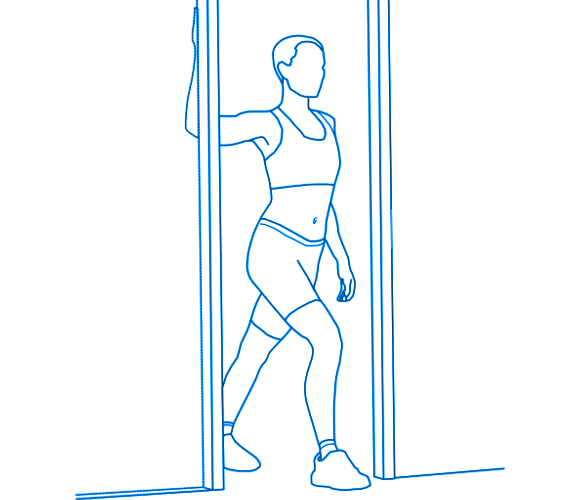
Tips & Pointers:
- Engage the core and hips to isolate stretch in each pectoral.
- Do not arch the back.
- Use the core to turn into each stretch.
- Keep head square with shoulders and keep chin tucked.
- Elbow should be at shoulder height when stretching.
7) Good Morning Stretch
Prolonged sitting due to sedentary occupations will usually generate tight hamstrings which put strain on the lower back. This form of imbalance and strain can create a “sway-back” posture through an upward pelvic tilt.
Good Morning Stretches increase flexibility of the hamstrings and stretch the lower back along with numerous external rotators in the hips and buttocks.
It is vital to maintain symmetrical positions of the feet, ankles, hips, and shoulders during each stretch through active recruitment of stabilizer muscles. By using proper form and range-of-motion, Good Morning Stretches can address neutral twisting between the hips and upper torso.
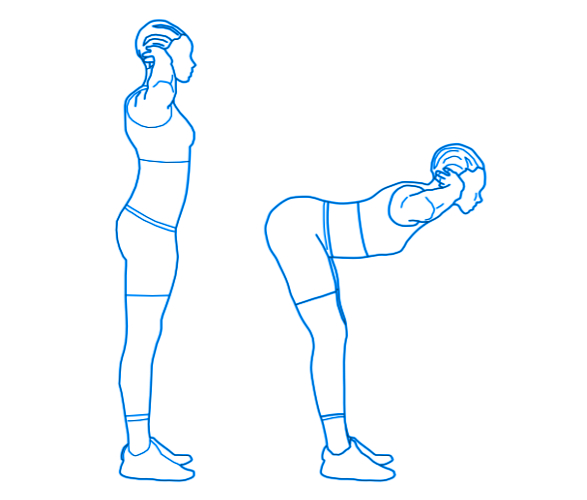
Tips & Pointers:
- Keep knees aligned above the ankles, keep feet parallel facing forward.
- Keep shoulders retracted throughout stretch.
- Keep back arched throughout stretch.
- Stretch by bending forward from waist; stabilize the position of the hips.
- Drive feet into the ground throughout stretch.
8) Face-to-Wall Squats
Squats are one of the most effective exercises to correct and improve posture. The key is performing them with proper form, control and symmetry. Those with tight hamstrings often face difficulties in maintaining an upright high-back posture during squats. Tight muscles in the lower back can challenge symmetrical, balanced form.
Face-to-Wall Squats are an effective exercise to build strict squat form while strengthening and stretching the posterior chain, legs, and hamstrings. Face-to-Wall squats encourage active recruitment of stabilizers and support muscles in the trunk, back and shoulders.
Another key to Face-to-Wall Squats Active is maintaining proper alignment of the feet, ankles, knees, and hips during each repetition. Working with a wall forces engagement of the upper back and shoulders to prevent “rounding out” due to poor squat form.
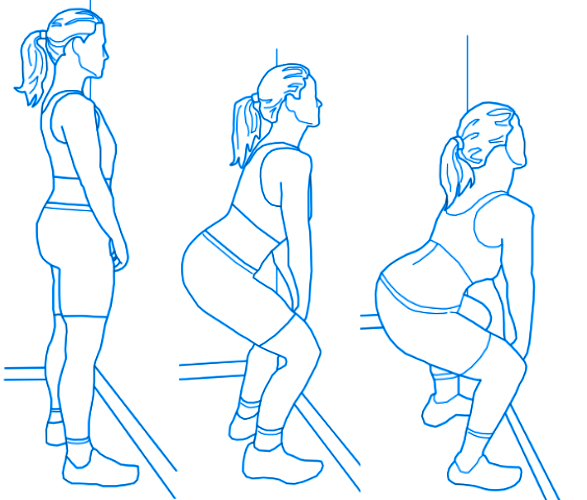
Tips & Pointers:
- Use the hips to control downward and upward motion.
- Keep knees directly aligned above the ankles.
- Keep the shoulders retracted and engaged.
- Maintain symmetry and control and exercise full range of motion through the hips.
- The goal is to be as close to the wall as possible without touching.
9) IT Band Stretch
The IT Band (iliotibial tract) is a band runs along the outside of the thigh and reinforces muscles of the hip, thigh, and knee. Uneven tension in the IT Bands creates asymmetry and strain of the hips.
Performing a simple IT band stretch will increase mobility of the hips while also relieving excessive outward rotation of the knee. This mobility and flexibility will improve form when executing exercises that train the posterior chain and lower body.
Tightness of the IT Band often results from physical training that generates uneven extension of the legs (IE running on a sloped shoulder without alternating direction), weakened glute muscles (often from sedentary occupations), and positions which hold the legs at externally rotated positions for extended periods.
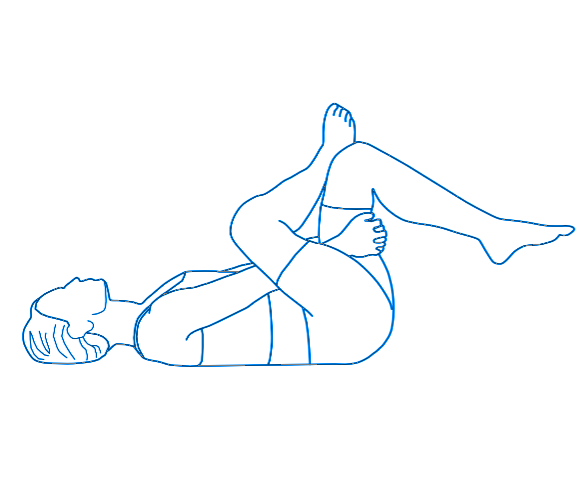
Tips & Pointers:
- Keep shoulders retracted and engaged during stretch.
- Keep chin tucked.
- Stretch slowly; do not force stretch.
- Push the crossed knee/leg by using outward rotation of the thigh.
- Be sure the lumbar rests flat on the ground while stretching.
10) Prone Cobra
Prone Cobras are very effective at addressing numerous signs of poor posture. As an exercise, prone cobras are trained as a continuous hold that targets the upper back, rear shoulders, lower back, and glutes.
Using the hips and shoulders to create a strong hold position, Prone Cobras also stretch the hip flexors and abdominal muscles. By pressing the chin down into the collarbone neck flexors and extensors can be trained to hold the held in neutral upright position.
As a hold exercise, key effort should be focused upon continuous engagement of the shoulders and hips while maintaining symmetry of the shoulders, arms, and legs.
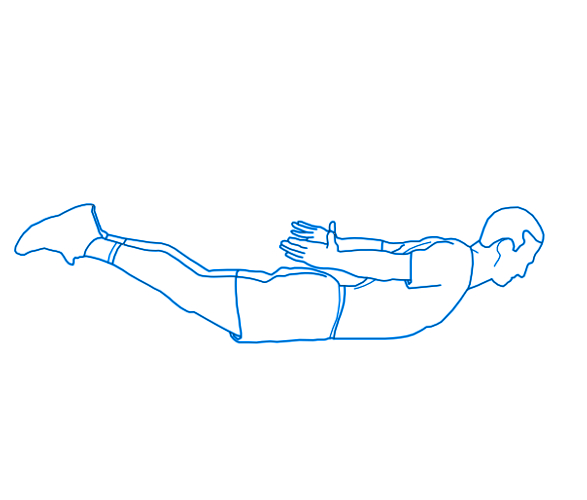
Tips & Pointers:
- Keep shoulders retracted & engaged.
- Keep palms open with thumbs pointing toward the sky.
- Use hip engagement (squeeze the glutes) to raise the legs off the ground.
- Keep the chin tucked and observe symmetry of the chest & shoulders.
- Beginners can split set into smaller chunks (IE 10 second holds for 3-6 sets).
Basic Warm-Up Routine (Beginner)
For beginners, start with minimum number of repetitions and time. Focus on form, symmetry, and full range-of-motion. Add repetitions and/or time per hold each week. Once the maximum number of reps or time for holds is reached, progress to the Basic Warm-Up Routine (Advanced).
| Exercise | Repetitions / Time | Sets | Notes |
| Jumping Jacks | 20 – 30 reps | 1 | Use a 4-count per rep. |
| Half Jacks | 20 – 30 reps | 1 | Use a 4-count per rep. |
| Torso Twists | 10 – 20 reps | 1 | Use a 4-count per rep. |
| Jumping Oblique Twists | 10 – 20 reps | 1 | Use a 4-count per rep. |
| Lat Stretch | 15 sec. hold | 2 | Use a supinated grip. |
| Pec Stretch | 15 sec. hold (each arm) | 2 | Elbow at shoulder height. |
| Good Morning Stretch | 15 sec. hold | 2 | Maintain arch in lower back. |
| Face-To-Wall Squats | 5 reps | 1 | Maintain alignment of ankles & knees. |
| IT Band Stretch | 15 sec. hold (each leg) | 1 | Stretch slowly; do not force stretch. |
| Prone Cobra | 30-60 sec hold | 1 | Use a stopwatch. |
Repeat the sequence as a standalone circuit workout (2 cycles).
Basic Warm-Up Routine (Advanced)
When starting the Advanced Basic Warm-Up, use minimum number of repetitions and time. Exercise with correct form, symmetry, and full range-of-motion. Add repetitions and/or time per hold each week. Feel free to repeat the sequence as a standalone circuit workout.
| Exercise | Repetitions / Time | Sets | Notes |
| Jumping Jacks | 30 – 40 reps | 1 | Use a 4-count per rep. |
| Half Jacks | 30 – 40 reps | 1 | Use a 4-count per rep. |
| Torso Twists | 20 – 30 reps | 1 | Use a 4-count per rep. |
| Jumping Oblique Twists | 20 – 30 reps | 1 | Use a 4-count per rep. |
| Lat Stretch | 15 sec. hold | 2 | Use a supinated grip. |
| Pec Stretch | 15 sec. hold (each arm) | 2 | Elbow at shoulder height. |
| Good Morning Stretch | 15 sec. hold | 2 | Maintain arch in lower back. |
| Face-To-Wall Squats | 5 reps | 2 | Maintain alignment of ankles & knees. |
| IT Band Stretch | 15 sec. hold (each leg) | 1 | Stretch slowly; do not force stretch. |
| Prone Cobra | 60 sec hold | 2 | Use a stopwatch. |
Repeat the sequence as a standalone circuit workout (3 cycles).
Do Not Skip the Warm up
Dismissing warm-ups is very common, often being skipped due to the extra time they add onto a workout session. One should consider how every professional sport and athletic activity employs an extensive warm-up session for every training session and competitive event.
Compound movements that demand timing, stability, and power benefit greatly from warm-up sets and exercises. Swinging a baseball bat, throwing kicks, and Olympic lifts all have been shown to benefit from warm-ups.
Training to improve posture is no different.
To improve posture through strength and flexibility training, it is important to acclimate and align the ankles, knees, hips, shoulders, elbows, and head through exercise. Building mobility through daily warm-ups will aid in form, control, and symmetry for other workouts.
Warm-ups acclimate the body and mind through exercises that provide gradual, controlled increases in effort. This helps achieve a state of bodily readiness for effective performance during training and competition.
Warm-ups stimulate the cardiovascular system through full-body movements and stretches that generate blood flow into muscles across the body, helping them assume size and leverage.
Balancing and controlling the body through range-of-motion exercises will build flexibility and mobility. This aids in proper alignment of the joints which can reduce the risk of injury.
Do not skip the warm-up.

